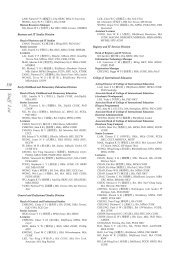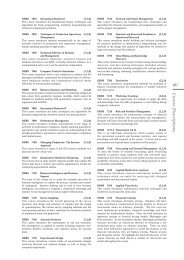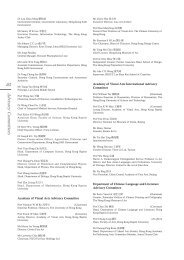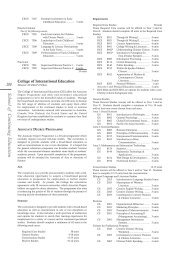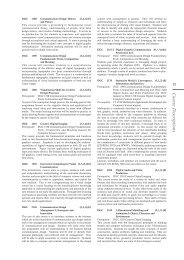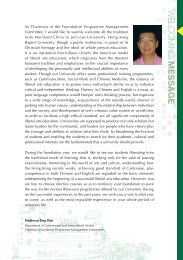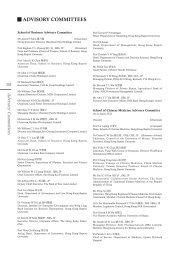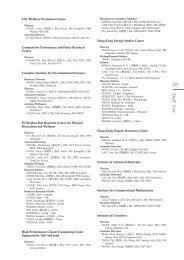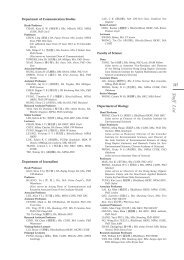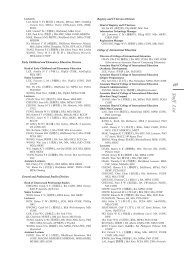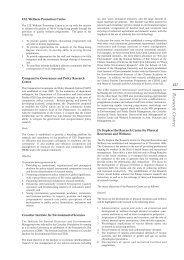366<strong>Course</strong> <strong>Descriptions</strong>knowledge and skills to facilitate effective, appropriate andaccurate human communication in various contexts, especiallycommunication in the interpersonal relationships with theirsignificant others, peers and superiors in their daily lives. Thecourse will increase students’ ability and sensibility to notecommunication patterns and processes, and to make active andconstructive choices during their interaction with other people.GDCV 1025 Communicating across Cultures (3,2,1) (E)The course covers basic concepts and practices underling thestudy of intercultural communication. This includes knowledgeand skills needed for everyone in an increasingly globalized world.Structures and barriers developed within and between culturesand how they may affect communication in life, work and societywill be examined, with special attention to local contexts (e.g.interaction with mainland parties, ethnic minorities in <strong>Hong</strong><strong>Kong</strong>, expatriate employees in international business or nongovernmental organizations).GDCV 1026 Critical Perspectives on (3,3,0)International NewsIn this course students examine in depth media coverage ofcurrent international and world issues. Students will learnabout the major players in international news and examine theiroperations. They will study how their news reaches consumersover a variety of platforms in today’s situation where thereare many new and unpredictable information suppliers on theinternet, which has made all news international by allowing accessfrom anywhere on the globe. Key international and/or worldevents happening during the semester will be selected for studentsto learn and practise the research, comparative and collaborativeskills.GDCV 1027 Media Studies in a Changing (3,2,1) (E)SocietyThe purpose of the course is to arouse students’ awareness ofthe role mass media play in their lives and society. It aims atdeveloping students’ critical analytical ability to deconstruct mediamessages. It also cultivates their skill of creative expression. Inthe Web 2.0 age, young people are living in a media saturatedworld. Their values and social actions are significantlyinfluenced by the media. With the rise of the Internet, mediacontent is not only produced by media professionals, but alsoby ordinary people. From YouTube to blogs, information isbeing circulated without filtering and verification. Traditionalmedia are also transforming their ways of delivering news andinformation. Therefore, being media literate becomes vital foryoung people to wisely interact with the changing society. Itis important for them to learn how to conduct news analysis.Media literacy is defined as a life skill which enables youngpeople to critically understand, analyse, use and monitor themedia. A social participative approach is adopted in this courseso that students are cultivated not only as active and critical mediaconsumers but also as informed and responsible citizens.GDCV 1035 News Production and (3,3,0)PresentationThis course will provide students with a basic understanding ofthe theoretical and practical issues underlying the productionand presentation of news. It will also provide a broad overviewof the complex relationship between news and society. Lookinginto how the presentation of news may affect the society on theone hand, the course also examines how the society may induceinfluence on news production on the other hand.GDCV 1036 Writing for Media (Chinese (3,3,0)Session)This course introduces students to the basic skills of mediawriting. Students will gain an understanding of the fundamentalconcepts and general principles of media writing. They willalso equip practical Chinese writing skills for media in local andMainland China context. Industry practitioners will be invited asguest speakers to share their working experience so that studentscan gain insights about media writing in real-lift context.GDCV 1037 Writing in English for News Media (3,3,0)This course will introduce students to a broad range of Englishnews media and equip them with a knowledge and understandingof the general principles of media writing and newsgathering.Students will analyse and critique news media writing; learn andpractise information gathering skills; develop and apply mediawritingskills in various styles for media such as newspapers,magazines, radio, television, press releases and online media; anddiscuss legal and ethical issues in media writing.GDCV 1045 “Art” as a Consumable (3,3,0) (E)The consumption of art has become a significant question in art,sociology and even tourism. Works of art have been producedand consumed like any other everyday life commodities from theancient times to the modern world, and the meaning of art hascontinuously been changing. Through studying the function ofart museums, galleries, art auctions and the mass media, studentswill be shown the creation and re-creation of meanings in worksof art, how they are understood and accepted by the public, andwhat cultural influences they may have generated in society atlarge.GDCV 1046 Aesthetics of the Young (3,2,0) (E)Young people have their own fashion, belief, slang, dialect, music,comic and behaviour that can be subversive to the conventionyet at the same time innovative, creative and non-prototype. Athorough investigation of the youth aesthetics will give newinsights to creativity and the visual arts. This practice-basedcourse will introduce various forms of creation within youthculture, including graffiti, popular image, fashion, YouTube,animation, comic in art and so on. Creative skills such as creativethinking, problem-solving for protests; theories such as the cultureof kidult and fans will be taught.GDCV 1047 All Arts: Creative Inspiration (3,3,0) (E)for LifeThis course will consider the historical, individual and crossculturalperspective, of different art forms, in order to placewithin the wider cultural framework and to gain a greater depthof knowledge about individual values of art. Key themes such asTheatre, Advertising, Product Design, Fine Art, Cookery, Filmand Architecture will be examined and discussed. Students willlearn to appreciate the elements of inspiration and how creatorscreate.GDCV 1055 Art and Gender (3,3,0) (E)This course will explore different aspects and forms of genderedimagery. Classes will also make links between gender in artand advertising, movies and fashion. Through the study ofgender in art from different cultures and period, students will beencouraged to analyse and question the construction of gender, itsmeaning, significance, but also the potential misunderstandings,misconceptions and mis-readings of it.GDCV 1056 Art Appreciation (3,3,0) (E)This course will offer students a broader understanding in visualarts. By studying works of art from different times and cultures,students will learn how to analyse, evaluate and appreciate variousart forms. It will explore a variety of art forms from across thestrata of creativity and examine themes including “Images ofHumanity”, “Belief and Religion”, “Love and Death”, “Scienceand Art” and issues of “Value”.GDCV 1057 Art for All—Public Art and Space (3,3,0) (E)This course encourages civic participation through activeengagement with urban sculpture on location around <strong>Hong</strong> <strong>Kong</strong>.It tracks the evolution of public and private space from the Greekagora and oikos through to the data driven concept of the mediacity where boundaries between public and private are permeableand in constant flux. Students will learn to appreciate <strong>Hong</strong><strong>Kong</strong>’s public space with an awareness of its societal and politicalstructure.
GDCV 1065 Buildings of <strong>Hong</strong> <strong>Kong</strong>: (3,3,0) (E)Appreciating ArchitectureExploring and enjoying the various architectural structures <strong>Hong</strong><strong>Kong</strong> has to offer on numerous site visits, the course will developan understanding of 20th century architecture in <strong>Hong</strong> <strong>Kong</strong>,with references to older periods and other cultural circles as well.It will thereby obviously consider the famous buildings of <strong>Hong</strong><strong>Kong</strong>, but also pay particular attention to under-appreciatedarchitecture of everyday nature, like the housing estate, the wetmarket, the industrial estate, the dai pai dong and others. Thiscourse has a focus on architecture, but will also make connectionsto urban planning and feng shui practices.GDCV 1066 Ceramics and Civilizations (3,3,0) (E)This course will offer a comparative study of ceramics toconsider how and why the formal quality of ceramics variesunder different cultural contexts. It will examine ceramics notonly from its political, socio-cultural and aesthetic backgroundsbut also a cross-cultural perspective. Popular subjects in thestudy of cultural theories, including body, social norms, religiousideas and economic life will be investigated in association withthe appreciation of ceramics. Students will acquire first-handexperience in making ceramics, learning basic techniques ofpottery, such as hand-building, wheel-throwing, moulding andsurface decoration, of which are essential processes for reflectingthe meaning of form and function, of how creativity andtechnological development contribute to the diverse cultures ofceramics.GDCV 1067 Chinese Calligraphy as (3,3,0) (E)Self-expressionChinese calligraphy is a unique form of art that integrates artisticelements in the visual forms of Chinese characters and theirliterary content. This studio-based course introduces the waysof appreciating this special art form, through practical studies inbasic brush techniques and styles of Chinese calligraphy with anemphasis on standard script (kaishu ) and semi-cursive script(xingshu ).Meanwhile, the relationship between calligraphy and the notionof self-expression will be examined through observations andanalysis of examples of calligraphic works by major calligraphers.Students will be guided to develop their own calligraphic skills andcreative strategies of expressing their own personal ideas throughmaking calligraphic works, allowing them to practice calligraphyas self-cultivation and part of a healthy lifestyle.GDCV 1075 Graphics Redesigned (3,3,0) (E)This course aims at developing students’ awareness towardsdifferent kinds of design they encounter, or they consume, ineveryday life. By looking at the design history of the past and thepresent, students will gain a better sense and knowledge in variouskinds of styles and trends. In each class, students will have theopportunity to re-design objects borrowed from everyday life, forexamples, packing of chewing gum, tea bag tag, chips packing,memo notes, or toilet paper, so as to rethink the relationshipbetween the designer, the products and the users.GDCV 1076 Encountering World Art (3,3,0) (E)Based on themes, such as body perception, belief of afterlife,personal and cultural identity, the course will examine subjectmatters, symbolism, styles, media, and aesthetic choices ofartworks within a variety of cultures and explore differentattitudes, beliefs, and thoughts embodied by the works. Thiscourse considers how factors of context influence visual elementsthat give meanings and values to a work of art, and how aestheticideas, techniques travel across cultures. While exploring thecomplex and rich world of visual arts, this course discusses criticalcultural issues embodied by the works, such as body politics,shaping of identities, and human existence and transcendence.GDCV 1077 Essentials of Chinese Art (3,3,0) (E)IdentityThe classical Chinese Art studio is a complex site of disciplineand reflection as well as pleasure and erudite jokes. Here wemay explore aspects of Chinese sensibilities towards space,furniture, sociality and functional tools that offer fresh insight intocontemporary sensibilities–for example, to design. The course isopened to students who may wish to develop their understandingand sensibilities for Chinese ink painting, calligraphy, seal carvingand art appreciation, as well as explores a particular aestheticwithin Chinese culture.GDCV 1085 Exploring Drawing (3,3,0) (E)People from different cultures tend to draw in different ways.Traditionally Chinese drew with ink and brush whereaswesterners used the ink pen or charcoal. Thanks to technologicaladvancement, many of us draw with the aid of computer softwarenowadays, from very simple software such as the palette onWindows to the more sophisticated Adobe Illustrator. Just likethe primitive people drew on rocks for communication purpose,we also perform similar acts of drawing on mobile phones withtouch screen functions today.Drawing is just as a fundamental tool in communication aswriting. To learn how to draw, whether on paper or other media,students will be able to explore the alternatives in expressingthemselves visually, thus having a better understanding ofthemselves and others. However to learn drawing does not onlymean the technical skills solely. This course aims to demonstratethe potential in/of drawing and inspire students to make use of itas a mean of visual expression.A better understanding and utilization in drawing can enhanceones analytical and communication skills. To achieve this thiscourse will introduce drawing samples from art history, explainthe differences in drawing approaches in various cultures as wellas introduce a selection of drawing practices through experimentaldrawing projects. Hence, students will learn different ways todraw, to look, to think, and also the significance of drawing inrelation to our everyday life.GDCV 1086 From Kitchen to Table: (3,3,0) (E)Ceramics and Food CultureCeramics plays a dominant role in our everyday life as manypeople use to cook and eat with ceramics utensils. This courseaims to investigate the ways we utilize and understand ceramicsin association with cooking and eating, in an art-historicaland socio-cultural aspects. The course will examine the form,design, composition and production method of different formsof ceramics, including the Chinese porcelain cup, the Japanesetenmoku, Mediterranean terracotta food vessels or the SoutheastAsian pottery.GDCV 1087 Looking at Asian Arts (3,3,0) (E)This course will introduce students to comparative approachesto major themes in the arts of Asia: from gardens in Suzhouand Kyoto, to contemporary architecture in Kuala Lumpur andShanghai, from Japanese to Korean TV drama, from the sensibilityof contemporary art in Taipei and Beijing, to the narratives ofIndian temples reliefs and Japanese mangas. It will also explorehow arts in Asia are used to establish cultural identities, and createmarketable images within a globalized context.GDCV 1095 Object and Heritage (3,3,0) (E)This course will explore the concepts of visual and materialculture in order to contextualize place, identity and heritage inboth a personal sense and within the large cultural boundaries.Exploring the formal qualities, functions and histories of “things”,it will discuss how objects shape our culture and how the materialworld is integral to meaning-making processes. It will alsointroduce material culture theories from various disciplines, e.g.anthropology, cultural studies and art theories, to critically studyobjects within a cultural and historical context. Further, it willinvestigate recent debates on urban development and heritagepreservation, things and memories, and, myths and traditionsassociated with them.367<strong>Course</strong> <strong>Descriptions</strong>
- Page 3 and 4:
economic growth, trade, pollution,
- Page 5 and 6:
specific empirical economic problem
- Page 7 and 8:
of private enterprises in the indus
- Page 9 and 10:
period. The first part of the cours
- Page 11 and 12:
The reactions and effectiveness of
- Page 14:
314Course DescriptionsEDUC 3080 Tea
- Page 17 and 18: development of children and adolesc
- Page 19 and 20: and communication skills in differe
- Page 21 and 22: y ubiquitous technology. Learners w
- Page 23 and 24: ENG 2650 Topics in English Grammar
- Page 25 and 26: clause structures of the English la
- Page 27 and 28: adopted for reading and interpretin
- Page 29 and 30: drama; and (2) introduce Western dr
- Page 31 and 32: ENGL 4005 Advanced Topic in Compara
- Page 33 and 34: attendant to the break-up of mediev
- Page 35 and 36: EURO 3205 Comparative Politics of (
- Page 37 and 38: states, enlargement provides signif
- Page 39 and 40: to create and develop ideas via rel
- Page 41 and 42: strategies of awarded campaigns to
- Page 43 and 44: characteristics of films, film-make
- Page 46: 346Course DescriptionsFINE 1005 Fin
- Page 49 and 50: GCHC 1005 China and the Global Econ
- Page 51 and 52: the period with a special focus on
- Page 53 and 54: est decision-making procedures. Mor
- Page 55 and 56: GCPE 1065 Table Tennis (1,2,0) (C)T
- Page 57 and 58: and/or philosophical traditions the
- Page 59 and 60: on the use of English in various se
- Page 61 and 62: GDAR 1835 Music, Mind, and Human (3
- Page 63 and 64: lead to successful development of n
- Page 65: management and proactive stakeholde
- Page 69 and 70: of various religions that broaden t
- Page 71 and 72: their implications for contemporary
- Page 73 and 74: gone through since 1945 included th
- Page 75 and 76: GEOG 1005 Geography and the Contemp
- Page 77 and 78: students to the concepts and techni
- Page 79 and 80: GEOG 3730 Energy Policy and Analysi
- Page 81 and 82: processes interact with China’s s
- Page 83 and 84: GERM 1006 German II (3,3,0) (G)Prer



